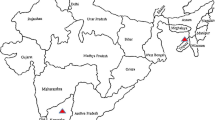Abstract
A phytoplasma-associated disease was identified in Brassica campestris (sarson) plants during a survey conducted in Punjab province of Pakistan in 2014–2016. The symptomatic plants showed characteristic symptoms of phyllody and witches’ broom. Phytoplasma presence was detected by polymerase chain reaction on 16S ribosomal and tuf DNAs, followed by RFLP analysis and sequence comparison of the 16S rRNA and tuf genes. The phytoplasma detected was classified in a new ribosomal subgroup designed 16SrIX-H. The phytoplasma presence in phloem tissues of symptomatic sarson samples was also confirmed through light microscopy and transmission studies to healthy plants through dodder and the leafhopper Orosius albicinctus. This is the first report of identification of 16SrIX-H subgroup phytoplasma associated with sarson and its natural vector in Pakistan.




Similar content being viewed by others
References
Ahmad, J. N., Pracros, P., Garcion, C., Teyssier, E., Renaudin, J., Hernould, M., Gallusci, P., & Eveillard, S. (2013). Effects of stolbur phytoplasma infection on DNA methylation processes in tomato plants. Plant Pathology, 62(1), 205–216.
Ahmad, J. N., Renaudin, J., & Eveillard, S. (2014). Expression of defense genes in stolbur phytoplasma infected tomatoes, and effect of defense stimulators on disease development. European Journal of Plant Pathology, 139(1), 39–51.
Ahmad, J. N., Ahmad, S. J. N., Arif, M. J., & Irfan, M. (2015a). First report of oil seed rape (Brassica napus) associated phytoplasma diseases and their insect vector in Pakistan. Phytopathogenic Mollicutes, 5(1-Suppl), S89–S90.
Ahmad, S. J. N., Ahmad, J. N., Irfan, M., Ahmad, M., & Aslam, M. (2015b). New reports of phytoplasma occurrence in Pakistan. Phytopathogenic Mollicutes, 5(1-Suppl), S71–S72.
Ahmad, S. J. N., Ahmad, J. N., Aslam, M., Rizwan, M., Ijaz, M., & Shabbir, M. (2015c). The wide occurrence of Parthenium weed associated disease and its potential insect vectors in the Punjab, Pakistan. International Parthenium News (pp. 9–10). Australia: Tropical and Sub-tropical Weed Research Unit, University of Queensland.
Akhtar, K. P., Shah, T. M., Atta, B. M., Dickinson, M., Jamil, F. F., Haq, M. A., Hameed, S., & Iqbal, M. J. (2008). Natural occurrence of phytoplasma associated with chickpea phyllody disease in Pakistan a new record. Plant Pathology, 57, 771.
Akhtar, K. P., Dickinson, M., Hodgetts, J., Abbas, G., Asghar, M. J., Shah, T. M., Atta, B. M., Ahmad, M., & Haq, M. A. (2009a). The phytoplasma disease 'mung bean phyllody' is now present in Pakistan. New Disease Reporter, 19, 37.
Akhtar, K. P., Sarwar, G., Dickinson, M., Ahmad, M., Haq, M. A., Hameed, S., & Iqbal, M. J. (2009b). Sesame phyllody disease: its symptomatology, etiology, and transmission in Pakistan. Turkish Journal of Agricultural Forest, 33, 477–486.
Amjad, M. (2014). Oilseeds crops of Pakistan (pp. 6–10). Islamabad: PARC.
Angelini, E., Clair, D., Borgo, M., Bertaccini, A., & Boudon-Padieu, E. (2001). “Flavescence dorée” in France and Italy - occurrence of closely related phytoplasma isolates and their near relationships to palatinate grapevine yellows and an alder yellows phytoplasma. Vitis, 40(2), 79–86.
Azadvar, M., & Baranwal, V. K. (2010). Molecular characterization and phylogeny of a phytoplasma associated with phyllody disease of toria, Brassica rapa L. subsp. dichotoma (Roxb.) in India. Indian Journal of Virology, 21, 133–139.
Azadvar, M., Baranwal, V. K., & Yadava, D. K. (2009). First report of a 16SrIX (pigeon pea witches’ broom) phytoplasma associated with toria (Brassica rapa cv. Toria) phyllody disease in India. New Disease Reporter, 20, 27.
Azadvar, M., Baranwal, V. K., & Yadava, D. K. (2011). Transmission and detection of toria [Brassica rapa L. subsp. dichotoma (Roxb.)] phyllody phytoplasma and identification of a potential vector. Journal of General Plant Pathology, 77, 194–200.
Bertaccini, A. (2007). Phytoplasmas, diversity, taxonomy and epidemiology. Frontiers in Bioscience, 2, 673–689.
Bertaccini, A. (2015). Phytoplasma collection. http://www.ipwgnet.org/collection.
Bertaccini, A., Vorackova, Z., Vibio, M., Franova, J., Navratil, M., Spak, J., & Nebesarova, J. (1998). Comparison of phytoplasmas infecting winter oilseed rape in the Czech Republic with Italian Brassica phytoplasmas and their relationship to the aster yellows group. Plant Pathology, 47, 317–324.
Bertaccini, A., Duduk, B., Paltrinieri, S., & Contaldo, N. (2014). Phytoplasmas and phytoplasma diseases: a severe threat to agriculture. American Journal of Plant Sciences, 5, 1763–1788.
Bhowmik, T. P. (2003). Oilseed brassicas constraints and their management. New Delhi: CBS publishers & Distributors.
Chapot, H. (1970). Les problémes de la production des agrumes au Proche-Orient et en Afrique du Nord, UNDP/FAO Report AT 2870. FAO: Rome.
Contaldo, N., Canel, A., Makarova, O., Paltrinieri, S., Bertaccini, A., & Nicolaisen, M. (2011). Use of a fragment of the tuf gene for phytoplasma 16Sr group/subgroup differentiation. Bulletin of Insectology, 64(Supplement), S45–S46.
Deenley, J., Stevens, W. A., & Fox, R. T. V. (1979). Use of Diene’s stain to detect plant diseases induced by mycoplasma-like organisms. Phytopathology, 69, 1169–1171.
Deng, S., & Hiruki, C. (1991). Amplification of 16S rRNA genes from culturable and non-culturable mollicute. Journal of Microbiological Methods, 14, 53–61.
Duduk, B., Paltrinieri, S., Lee, I.-M., & Bertaccini, A. (2013). Nested PCR and RFLP analysis based on the 16S rRNA gene. Methods in Molecular Biology, 938, 159–171.
Horváth, J. (1969). Green petal: a new disease of rape in Hungary. Acta Physiologica Academiae Scientiarum Hungaricae, 4, 363–367.
Hoshi, A., Ishii, Y., Kakizawa, S., Oshima, K., & Namba, S. (2007). Host parasite interaction of phytoplasmas from a molecular biological perspective. Bulletin of Insectology, 60, 105–107.
Kamińska, M., Berniak, H., & Kamiński, P. (2012). Detection of ‘Candidatus Phytoplasma asteris’ infection in Brassica spp. plants with flower bud failure in Poland. Acta Horticulturae, 960, 351–358.
Khan, A. R., & Munir, M. (1986). Rapeseed and mustard problems and prospects. In Oilseed research and development in Pakistan – a perspective. Proceedings of National Seminar on oilseed Research Development in Pakistan, May 7–9. Islamabad: NARC.
Khan, A. R., Munir, M., & Yousf, M. A. (1987). Rapeseed and mustard problems and prospects (p. 1). Islamabad: Pakistan Agricultural Research Council.
Kolte, S. J. (1985). Diseases of annual edible oilseed crops (pp. 83–122). Inc, Boca Raton: Vol. II. Rapseed-Mustard and sesame diseases. CRC press.
Lee, I-M., Bertaccini, A., Vibio, M., & Gundersen, D. E. (1995). Detection of multiple phytoplasmas in perennial fruit trees with decline symptoms in Italy. Phytopathology, 85, 728–735.
Lee, I-M., Bottner-Parker, K. D., Zhao, Y., Bertaccini, A., & Davis, R. E. (2012). Differentiation and classification of phytoplasmas in the pigeon pea witches’ broom group (16SrIX): an update based on multiple gene sequence analysis. International Journal of Systematic and Evolutionary Microbiology, 62, 2279–2285.
Lehmann, W., & Skadow, K. (1971). Untersuchungenzur Verbreitung Atiologie und Vektoru bertragbarkeit der Blutenvergrunung des Rapes. Archives Phytopathologiche Pflanzens, 7, 323–336.
Makarova, O. V., Contaldo, N., Paltrinieri, S., Kawube, G., Bertaccini, A., & Nicolaisen, M. (2012). DNA barcoding for universal identification of ‘Candidatus phytoplasmas’ using a fragment of the elongation factor tuf gene. PloS One, 7(12), e52092.
Olivier, C. Y., Galka, B., & Séguin-Swartz, G. (2010). Detection of aster yellows phytoplasma DNA in seed and seedlings of canola (Brassica napus and B. rapa) and AY strain identification. Canadian Journal of Plant Pathology, 32(3), 298–305.
Sackston, W. E. (1953). Rape. Canadian Plant Disease Survey, 33, 41.
Salehi, M., Izadpanah, K., & Siampour, M. (2007). Characterization of a phytoplasma associated with cabbage yellows in Iran. Plant Disease, 91, 625–630.
Salehi, M., Izadpanah, K., & Siampour, M. (2010). Occurrence, molecular characterization and vector transmission of a phytoplasma associated with rapeseed phyllody in Iran. Journal of Phytopathology, 159, 100–105.
Schneider, B., Seemüller, E., Smart, C. D., & Kirkpatrick, B. C. (1995). Phylogenetic classification of plant pathogenic mycoplasma-like organisms or phytoplasmas. In S. Razin & J. G. Tully (Eds.), Molecular and diagnostic procedures in Mycoplasmology (Vol. I, pp. 369–380). San Diego: Academic Press.
Tamura, K., & Nei, M. (1993). Estimation of the number of nucleotide substitutions in the control region of mitochondrial DNA in humans and chimpanzees. Molecular Biology and Evolution, 10, 512–526.
Tamura, K., Stecher, G., Peterson, D., Filipski, A., & Kumar, S. (2013). MEGA6: molecular evolutionary genetics analysis version 6.0. Molecular Biology and Evolution, 30, 2725–2729.
Wang, K., & Hiruki, C. (2001). Molecular characterization and classification of phytoplasmas associated with canola yellows and a new phytoplasma strain associated with dandelions. Plant Disease, 85, 76–79.
Weintraub, P. G., & Beanland, L. (2006). Insect vectors of phytoplasmas. Annual Review of Entomology, 51, 91–111.
Zhao, Y., Wei, W., Lee, I.-M., Shao, J., Suo, X., & Davis, R. E. (2009). Construction of an interactive online phytoplasma classification tool, iPhyClassifier, and its application in analysis of the peach X-disease phytoplasma group (16SrIII). International Journal of Systematic and Evolutionary Microbiology, 59, 2582–2593.
Acknowledgement
This research was supported by funds from Higher Education Commission (HEC), Pakistan and FICP research grant.
Author information
Authors and Affiliations
Corresponding author
Additional information
GenBank accession number of DNA sequences KT253604 and KU892213.
All authors have reviewed the manuscript and approved its submission to European Journal of Plant Pathology. The manuscript has not been submitted elsewhere.
Rights and permissions
About this article
Cite this article
Ahmad, J.N., Ahmad, S.J.N., Aslam, M. et al. Molecular and biologic characterization of a phytoplasma associated with Brassica campestris phyllody disease in Punjab province, Pakistan. Eur J Plant Pathol 149, 117–125 (2017). https://doi.org/10.1007/s10658-017-1170-4
Accepted:
Published:
Issue Date:
DOI: https://doi.org/10.1007/s10658-017-1170-4




